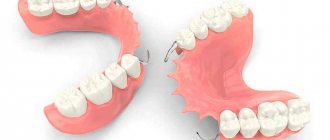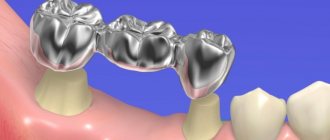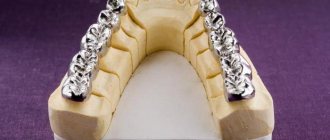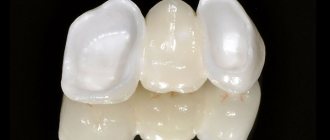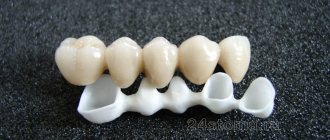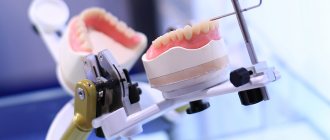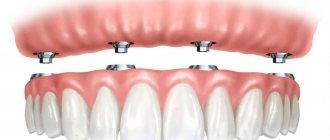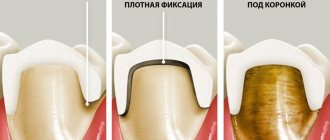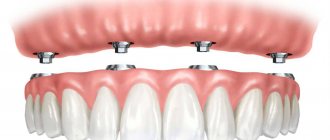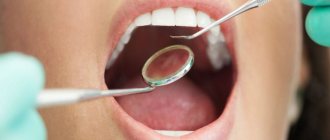The widespread introduction of casting technology into the practice of dental laboratories has allowed foundry specialists to make thin-walled and high-precision solid-cast crowns from metals and medical alloys, designed to eliminate obvious defects in the dentition.
Such prosthetic devices are widely used in modern dental practice to restore the natural anatomical shape of damaged teeth or as supporting and fixing elements for prosthetic structures.
General overview
A non-removable dental structure that restores the integrity of the dentition with a partial defect is called a bridge-like prosthesis or “bridge”.
These include a soldered prosthesis. It consists of stamped metal crowns and a cast intermediate part. The structural elements are soldered together and fixed to the supporting teeth.
Stamped crowns are made from standard blanks (caps) of stainless steel or, sometimes, gold.
If the purpose of prosthetics is to eliminate slight pathological mobility of adjacent teeth, the prosthesis will consist of crowns welded together.
In the absence of one or more teeth in the jaw, the defect is replaced with an intermediate part cast from metal, which is soldered to the supporting crowns.
Why are all-metal crowns losing their relevance?
Article navigation
- What is the product
- In what cases are such crowns installed?
- Arguments for and against cast structures
- What are the types of cast products?
- What materials are these crowns made from?
- How structures are produced and installed
- Approximate prices
- How to care for cast dentures
- FAQ
Question for a specialist
In Soviet times, crowns made of ordinary metal looked familiar, and gold crowns were considered chic. Today, the idea of aesthetics has changed, dentistry has stepped far forward, and many modern clinics have completely abandoned this type of prosthetics. However, solid metal crowns are still installed in a number of cases - mainly as a budget option for dentition restoration.
Read about what these structures are made of, as well as their improved types, in today’s article.
Types of bridges
There are various types of bridges, differing in materials, manufacturing methods, location of the intermediate part, the nature of the adhesion of the elements and some other features.
Classification of bridges:
- By material: ceramic, metal, combined.
- By manufacturing method: cast, soldered.
- By fastening method: removable and non-removable.
- According to the position of the intermediate department: flushing and tangential.
- According to the position of the supports: double-sided and cantilever (when only one supporting tooth is involved).
- By type of abutment crowns: full, equatorial, inlays, pins, etc.
Solid cast
A cast bridge is made using casting, which creates a complete bridge without the need to solder individual elements. In the process of manufacturing a solid-cast bridge prosthesis, errors in the accuracy of the design are excluded, and the phenomenon of heterogeneity of metals does not arise (as in the case of prosthetics with stamped-soldered bridges). The material most often used is cobalt-chrome alloy.
The disadvantages of solid-cast bridges are unsatisfactory aesthetics - despite the fact that the design completely recreates the anatomical shape of the teeth, the metal is very noticeable in the oral cavity, however, if desired, the cast frame can be lined with ceramics or plastic. Another disadvantage of the cast structure is its weight - the prosthesis turns out to be quite heavy. This type of orthopedic design is most often used for budget prosthetics of the lateral group of teeth.
Soldered
Stamped-soldered bridges are a structure of stamped crowns welded together. This orthopedic design is currently used quite rarely, since it is of low quality.
In addition, stamped-soldered bridges negatively affect the condition of the oral mucosa - due to the use of several dissimilar metals, galvanic currents arise in the oral cavity, causing many diseases.
The technology for manufacturing stamped crowns does not allow for a tight fit on the supporting teeth, because of this, saliva constantly leaks in the neck area, food debris gets clogged and plaque accumulates. All this ultimately leads to the formation of caries, which is quite difficult to recognize under the crown in time. Read more about the causes of caries→
Metal-ceramic
The next step in construction is metal-ceramic bridges. This type of “bridge” made it possible to significantly expand the scope of application of solid bridges by covering them with ceramics. The statement “coating them with ceramics” is not entirely correct, since such a design of prostheses implies not just a full-metal coating, but a modification of the structure, which is why a metal-ceramic bridge consists of a metal frame and a ceramic lining. This determined its advantages and disadvantages.
Advantages:
— Significant increase in aesthetic characteristics compared to solid bridges
— Expanding the scope of application, which suggests the possibility of using such a design in the restoration of defects in the frontal group of teeth
— The almost complete correspondence of this type of prosthesis to the natural appearance of teeth allows for rapid psychological adaptation of patients to them, which largely restores the level of quality of life.
Flaws:
— The lack of a chemical bond between the metal frame and the ceramic cladding suggests the possibility of chipping the ceramics
— The still presence of metal in the oral cavity can cause allergic reactions, galvanism effects and the negative impact of metal on tooth tissue and their staining.
The aesthetics of metal-ceramic prostheses is relative. Regarding solid-cast bridges, this prosthesis design is far ahead, however, the transmission of metal through ceramic masses and designs with a “garland” do not allow us to compare the aesthetic qualities of such a prosthesis with an all-ceramic one.
However, it is important to note that replacing the cobalt-chromium alloy, which is most often used to make metal frames, with noble alloys with a high gold content allows you to achieve beautiful aesthetics.
The natural color of gold, shining through ceramic masses, allows you to recreate the natural color of teeth. Along with the advantages of metal-ceramic prostheses, avoiding the disadvantages of all-ceramic bridges, this design takes a leading position in matters of aesthetics and functionality.
This is interesting: Crowns on teeth - what are they: which ones are better to install and why
All-ceramic
All-ceramic bridges have confidently taken the position of one of the most aesthetic and functional structures. This explains that manufacturing companies most often improve the methods of manufacturing just such prostheses. Computer modeling and milling are increasingly being introduced into the daily routine of dental practice. The development of such technologies makes it possible to increasingly reduce the production time of bridges, down to one visit to the dentist.
Methods of layer-by-layer application of ceramic masses with restoration of the smallest tooth structures help create prostheses that are as close as possible to the appearance of natural teeth. Due to the strength properties of modern ceramic materials, metal-free bridges have excellent functional characteristics, but this also has a downside.
While metal-ceramic dentures have some degree of compliance, all-ceramic dentures have a much lower elastic modulus. Because of this, loads leading to chipping of ceramics in metal-ceramic structures can lead to failure of metal-free “bridges” with the need for their complete replacement, while chipping of ceramics can be corrected in a clinical setting.
And, however, despite this drawback, all-ceramic bridge designs are the most progressive and will set the vector for the development of materials and manufacturing technologies.
Bridges supported on tabs
Not only full crowns, but also metal or ceramic inlays can be used as supports. Metal structures are manufactured using the casting method, ceramic ones using CAD/CAM technology. The main difference between such dentures is that there is no need for extensive preparation of the supporting teeth - it is enough to make recesses for the inlays. Read more about adhesive prosthetics→
Console
A cantilever bridge differs from a conventional one in that only one tooth on one side is supported. This design is used when the patient is missing one tooth in the dentition, most often in the anterior section. The part that hangs over the defect area is called the console.
It is not recommended to use cantilever bridges to restore missing molars - when chewing, the load is distributed unevenly, causing loosening of the supporting tooth. In addition, the bridge in such a situation begins to act as a lever, which is why the structure may overturn.
Adhesive
More and more often, an alternative to the work of an orthopedic dentist is offered in the form of adhesive bridges, which can also be made at an appointment with a dentist-therapist, if the latter has sufficient skills. Adhesive bridges are made using composite materials using fiberglass tape, as an analogue of the bridge frame, or using conventional orthodontic wire.
This combination makes it possible to make dentures directly in the patient’s mouth, in one visit with minimal preparation of the supporting teeth, which significantly reduces the financial component of the issue.
However, the functional qualities of such prostheses are not always satisfactory, and the aesthetic qualities of composite materials cannot often compete with those of ceramic materials due to the impeccable polishing and natural shine of the latter. But with the right choice of such a treatment method, for the restoration of small-length defects in the dentition in the lateral sections, extending beyond the aesthetic zone, in sections with a lower functional load, such a design of bridge prostheses turns out to be extremely logical and appropriate: the dentures have a long service life, providing patients wonderful appearance.
Removable
A removable bridge is a structure consisting of supports that transmit chewing pressure to the dentition through clasps or special locks - attachments. This design is used in cases where fixed prosthetics are impossible for one reason or another.
What is the product
Solid dental crowns got their name based on their manufacturing technology - they are produced using a one-stage casting method in a mold. Models made from individual casts have the anatomical shape of the teeth of the future owner. In this way, it is possible to make both a single product and a bridge to replace several teeth - the technology allows you to do without soldering, which significantly saves time.
Indications and contraindications
The installation of soldered bridges is indicated when restoring your own lost teeth with artificial structures. They are used if no more than 4 teeth in a row are missing in one of the rows.
In addition, the model in question can be placed for the following indications:
- various damage to the crown parts of natural teeth;
- anomalies of shape and unnatural position;
- treatment of enamel coating abrasion;
- pathological occlusion;
- disturbances in the functioning of the masticatory muscle group;
- small teeth.
It is not recommended to use this technique in the following conditions:
- defects that disrupt the orientation function of periodontal tissue fibers;
- chronic diseases caused by viral infection (for example, tuberculosis);
- allergies to the alloys used;
- extensive defects;
- deep traumatic occlusion;
- pathologies associated with high mobility of dental units in the presence of a low crown part, weakened periodontium;
- inflammatory diseases (gingivitis, periodontitis);
- bruxism;
- serious pathologies in which the condition and quality of bone tissue changes (for example, with osteomyelitis or osteoporosis);
- psychoneurology;
- blood diseases;
- chronic form of certain somatic diseases that are in the acute stage;
- poor oral hygiene.
Important: many of the listed contraindications can be considered relative. Their elimination makes prosthetics possible.
Service life and care
With proper care, a solid-cast bridge can last for 15 years without breaking. The service life of such a product is practically unlimited, but it is important to visit a doctor regularly in order to identify problems in time and solve them at the initial stage.
What you need to do to properly care for a solid bridge:
- regularly clean your mouth in compliance with standard hygiene rules;
- use a toothbrush, dental floss and a special brush daily to clean the spaces between the gum and the structure;
- use an oral irrigator several times a week;
- visit the dentist every few months for professional oral hygiene and assessment of the condition of the orthopedic structure;
- rinse and clean the mouth after each meal, for which it is enough to use a deodorizing mouthwash or a solution prepared at home from herbs, which will prevent inflammatory diseases.
Important! Installation of a one-piece denture makes it impossible to carry out standard professional oral hygiene. The dentist uses special cleaning products and brushes to clean your teeth. It is also unacceptable to use the irrigator in high pressure mode, directing the stream at the prosthesis.
Pros and cons of the design
The positive aspects of these prostheses include:
- Small wall thickness , which requires the removal of only a small amount of dental tissue during preparation.
- Low cost.
The disadvantages of these designs are much greater than the advantages:
- Due to the peculiarities of creating the prosthesis, there is no precise fit to the supporting teeth. The consequence of this deficiency is the development of caries, leading to rapid destruction.
Also, an inaccurate fit can cause injury to the gum tissue with subsequent development of inflammation. - Rapid erasure of the crown walls due to their small thickness. This fact also leads to loss of functionality of the prosthesis and breakdowns.
- The metals contained in solder often provoke adverse reactions from the body - redness and irritation of the tissues of the oral cavity, digestive disorders, and severe discomfort.
- The appearance of an unpleasant taste in the mouth and bleeding gums due to oxidation of the metal by saliva.
- The strength of soldered structures is inferior to the strength of solid cast ones.
- The crowns have an unclear relief of the chewing surface , which leads to impaired chewing of food and problems with the mandibular joint.
- Rapid darkening of the soldering line , which worsens the overall aesthetics of the smile (especially if the anterior group of teeth was restored).
- The occurrence of a complication – galvanism, i.e. metal intolerance in the form of allergies.
This is interesting: Basics of prosthetics with Duceram metal-ceramic crowns
Important: a large number of disadvantages led to a sharp decrease in patients’ demand for the installation of soldered prostheses.
In the video, the doctor talks in more detail about the pros and cons of bridges.
The main advantages of solid crowns
The most important advantages of solid dental crowns are:
- the highest precision of fit of the cast inner part of the crown to the tooth stump (the width of the gaps between the inner part of the prosthetic device and the surface of the tooth does not exceed several microns, and this allows you to avoid saliva, pieces of food and pathogens getting inside the crown);
- availability of spraying on the surface of the crown;
- strength and high wear resistance of the finished crown;
- availability of opportunities to recreate the natural chewing surface of the tooth;
- restoration of the chewing function of a tooth covered with a solid crown;
- availability of opportunities to recreate optimal interdental contacts;
- biological inertness, lack of toxic effects on the tissues of the human body;
- affordable prices for the production and installation of solid crowns;
- reliability (soldering is not required for the manufacture of solid-cast crowns: the prosthesis is solid and consists of one metal or alloy, which makes it more resistant to damage);
- durability of the prosthetic device (the service life of solid-cast prosthetic devices, subject to the rules of use, can exceed 10 years).
Clinical and laboratory stages of manufacturing a bridge prosthesis
Stages and their features (K - clinical, L - laboratory):
- K - the dentist makes a diagnosis, selects the type of construction together with the patient, prepares the abutment crowns, after which impressions are taken.
- L - creation of a plaster model, selection of the color of the prosthesis, creation of a temporary structure.
- K - fitting the temporary product, checking occlusion.
- L - casting of a permanent bridge structure.
- K - fitting of the prosthesis.
- L - cladding or spraying.
- K - installation of the structure in the oral cavity, assessing the quality of its fit, fixation with special cement.
The prosthetic procedure will require 2 visits to the dentist’s office:
- First. The defect is assessed, the doctor considers the optimal restoration options, and clarifies with the patient which restoration method is preferable. On the first visit, the oral cavity is sanitized and the supporting elements are ground. The dentist takes impressions, sends them to the laboratory and places temporary aligners.
- Second. The dentist places a ready-made solid bridge, finds out how well it fits the patient, and whether there are any defects. When everything is in order, the structure is fixed with composite cement.
Important! When there are inflammatory pathologies of the mucous membrane or other relative contraindications, several visits to a specialist will be required until the problem is eliminated.
If the quality of the finished product does not match, it will require correction. In this case, prosthetics will also be extended over more than two visits.
What are the types of cast products?
Modern dentistry has significantly expanded the arsenal of metal casting products. Today the patient can choose designs:
- without spraying: they have a regular metal surface, polished to a shine. Aesthetics are reduced to zero,
- with spraying: to give a white color or a “gold” tint, the solid crown is treated with a special composition using vacuum plasma equipment,
- with partial cladding: ceramic or plastic linings are fixed to the front parts of the products. The teeth look natural, while the design will cost less than classic metal-ceramics,
- with full cladding: this option can no longer be called a product made only of metal. These are rather combined metal-ceramic crowns. Such designs are superior to all others in aesthetics and retain strength due to their metal base.
Spraying options are not suitable for everyone: compositions that are applied to the surface can irritate the oral mucosa. Therefore, to achieve aesthetics on a limited budget, it is still better to choose designs with front cladding, although they also have a drawback - cracks and chips often appear on the linings.
Production technology
Creating soldered prostheses is a complex and lengthy process. It includes several mandatory clinical and laboratory stages.
Taking impressions
Before taking impressions, a set of primary measures is carried out, the purpose of which is to ensure the functionality of the dentofacial apparatus and its future health.
It includes a comprehensive examination and therapy of the patient’s oral cavity in identifying diseases.
The following actions of the dentist are aimed at directly preparing the teeth for prosthetics. If there are indications, the supporting units are necessarily cured, and if necessary, the nerves are also removed .
After preparing the oral cavity, the supporting teeth are prepared (grinded). This manipulation provides conditions for reliable fixation of the crowns, and consists in removing a certain layer of dentin from the surfaces of these elements.
The preparation must take place under local anesthesia with simultaneous cooling of the treated area. The size of the removed tissue layer is always equal to the thickness of the walls of the artificial crown, which is 0.3 mm.
During the process, the doctor makes sure that the walls undergoing the procedure are parallel.
At the end of all actions, an impression is taken. For this, a standard impression tray and alginate mass are used. Instead of alginate, you can use dental plaster, but due to the labor-intensive nature of the work, it is used in isolated cases.
Important: to improve the retention of the material, it is proposed to treat the edges of the impression tray with adhesive.
After the impression is removed from the oral cavity, it is checked and disinfected. If the patient develops sensitivity and mild pain on the prepared units, the exposed dentin is treated with a desensitizer.
While a permanent prosthesis is being manufactured, the doctor may recommend a temporary one, which will allow the jaws and tissues to get used to the changes. The temporary structure will also protect the treated surfaces from unwanted infection.
In addition, to prevent the occurrence of inflammation in periodontal tissues, regenerative and anti-inflammatory therapy is prescribed.
Model making
The sample is cast in the laboratory by a technician using an impression sent by the dentist.
Modeling the prosthesis body
A roller made of wax fills the space between the artificial teeth. The roller itself is made a little wider and higher than the crowns. While the material is warm, the models are closed to obtain an imprint of the antagonists.
Next, dental elements are modeled from the roller. To do this, first remove excess wax and ensure that the parameters of the roller are identical to the size of the adjacent teeth.
Afterwards, the roller is marked into sections, the number of which is equal to the number of missing units, and each tooth is modeled separately, taking into account the anatomical features of all their surfaces.
To prevent injury to the mucous membrane of the tongue when wearing a prosthesis, do not make a sharp transition between dental units on the oral (lingual) side. On the contrary, this surface is made smooth without sharp boundaries. The cusps of the molars are formed weakly pronounced, slightly rounded.
If the height of the supragingival part, turned towards the site of the defect, is insufficient, a process is retracted from the prosthetic structure to the oral side, which helps to increase the area of contact with the bridge.
Casting
The product then goes to the foundry. There the wax part will be replaced with metal.
Casting process steps:
- start by installing the pins into the wax composition and create a gating system;
- cover the models with a refractory substance;
- the wax composition is immersed in a refractory mass;
- the wax is melted down;
- dry models;
- melt an alloy of metal;
- the alloy is poured;
- free the cast parts of the prosthesis from the sprues and refractory mass.
Having completed the casting process, the foundry technician completely cleans the parts from any remaining refractory mass.
Soldering parts
When all the components are ready, they begin to connect all parts of the structure into one whole, that is, they begin to solder. For this, a special alloy (solder) is used, with a lower melting point than that of the main parts.
This is interesting: Lumineers and veneers: how they differ and what is better to install
Solder Requirements:
- solder should melt at a lower temperature than the base metals and have small melting temperature limits;
- when heated, have fluidity;
- penetrate into the thickness of base metals;
- be stable in acidic and alkaline environments;
- harmonize in color with base metals;
- resist corrosion in the mouth;
- the physical and mechanical characteristics of the solder must correspond to the metals being soldered;
- do not bubble when working.
First, all parts of the structure are fixed with molding compound, placed in a fume hood on a fireproof block and heated with a burner flame. Then the flame is reduced and they continue to work with a narrow beam of flame, trying not to overheat the crowns.
Soldering of parts of structures intended for prosthetics is carried out using solder until the gap between the parts is completely filled.
To absorb oxygen, which is involved in the formation of an oxide film, fluxes are used, most often borax is used for this.
The process of soldering steel structures for prosthetics requires some experience. If during work the beginning of melting of the solder is missed, an oxide film appears on the metal, resulting in a false solder at the joint, since the solder will not be able to penetrate between the parts, and the connection will only be superficial.
Soldering fragments of gold or other metals is carried out in a similar way, using solder intended for the metals used.
Finishing
Having finished soldering the metal parts of the bridges, the structure is washed in cold water, cleaned of remnants of the refractory mass, then bleached in a 40% solution of hydrochloric acid.
The final finishing is done with files, carborundum stones, separation discs, and burs.
These tools are used to remove solder deposits, smooth out all roughness on cast parts, and treat chewing surfaces and interdental spaces with special care.
After the initial cleaning, the dentures are polished first with coarse, then softer brushes , rubber wheels, using a grinding mass in the form of a slurry. These tools are driven by a grinding motor.
Polishing is carried out with green Goya paste. At this point, the process of making the prosthesis is completed, and it is ready for fixation in the oral cavity on the prepared supporting teeth.
Installation of stamped metal crowns
Fixation of crowns is carried out only after treatment of identified dental diseases. The prosthetic process involves tooth preparation, but the layer of bone tissue removed is minimal compared to other methods of restoring the dentition.
Preparatory work is carried out in the following sequence:
- Removing the top layer of enamel (0.3 mm). The work is performed with a special diamond disc.
- After preparation, the orthopedist checks the gaps between the causative and contacting teeth. The interval should correspond to the thickness of the crown. Control is carried out using a wax sheet.
- The next step is to prepare all contact surfaces (adjustment to the thickness of the crown).
- The process is completed by preparing the oral and vestibular parts of the tooth in order to give the stump a cylindrical shape. The diameters of the stump and neck of the tooth must be the same.
Installation of a crown made of stamped metal is carried out in the following order:
- examination by a doctor of the oral cavity to ensure the absence of inflammatory processes;
- quality control of preparatory work;
- fixing the crown to the stump by applying cement to the joint.
Upon completion of prosthetics, the doctor gives recommendations to the patient on caring for the oral cavity and, in particular, the crown.
Stages of crown installation
Preparation for prosthetics
Preparation for the installation of an orthopedic structure can be therapeutic, surgical, orthopedic and orthodontic. Types of preliminary sanitation can be combined, depending on the condition of the oral cavity and the type of defect.
How do you prepare for prosthetics at the dentist:
- Assessment of oral health.
- Carrying out professional cleaning to remove hard dental deposits.
- Carrying out anti-inflammatory therapy if necessary.
- Removal of carious cavities, treatment of pulpitis, periodontitis and other existing pathologies of teeth and mucous membranes.
- Depulpation of teeth (according to indications).
The surgical type of preparation includes the following activities:
- Removal of teeth that cannot be treated. Indications include chronic periodontitis, cysts, and pathological mobility of crowns.
- Removal of soft tissues due to their hypertrophy (hypertrophic gingivitis).
- Complex treatment of dentofacial pathologies.
Orthodontic preparation includes returning the normal bite of healthy teeth through the use of braces, aligners, and plates. Treatment is necessary to correct the position of individual abutment crowns and to create space in the oral cavity for fixation of the bridge structure.
The orthopedic preparation stage includes procedures such as:
- Making corrective aligners to move the advanced crown to the opposite side where the tooth is missing. In this way, the orthopedist creates a place to install the structure.
- Making functional mouthguards to relax the masticatory muscles. Such an event is indicated for hypertonicity in order to prevent breakage of the bridge after installation.
Durability
Experts recommend not to wait for complications to arise and to consult a doctor promptly.
The metal alloy stamping is quite thin, so during the operation of the crown it wears out quickly.
The surface, which is often in contact with other teeth, is subject to abrasion.
This explains the short service life, which is indicated by 3-5 years.
Fragility is due to other factors:
- the presence of a gap between the structure and dentin, which provokes the development of caries and other dental problems;
- crown deformation as a result of eating hard foods.
Experts recommend not waiting for complications caused by the above reasons to occur.
Every 2-3 years, crowns simply need to be replaced with new ones, even if the old ones have not yet lost their aesthetic appearance. It is difficult to assess the condition of dentin under the structure, so there is a need for revision.
Advantages and disadvantages
| pros | Minuses |
| Homogeneous design, lack of solder, which increases the strength of the product. Unlike other prostheses, solid ones almost never break, because there are no weak joints | Low aesthetics |
| High strength and durability | The cost is higher than a cast prosthesis |
| Tight fit to the tooth, which prevents food particles from getting under the crown, and this prevents secondary caries and destruction of enamel under the prosthesis, and also reduces the likelihood of damage to the structure | Great thermal conductivity |
| High functional efficiency due to precise modeling of support elements and intermediate parts | Risk of discomfort when eating hot food |
| No darkening factor in the structure in the soldering area | Cannot be determined in case of metal allergy |
| Wax can be used to thicken the walls of an orthopedic product. | The need to grind healthy crowns, which over time leads to their destruction due to malnutrition |
| The one-piece design is better tolerated by patients, the risk of prosthetic stomatitis is reduced | High load on abutment teeth can cause them to become loose |
total cost
The price of a soldered prosthesis compares favorably with all other options for analog designs. The estimated cost of one artificial crown is 800 rubles.
Considering that to install a prosthesis from just one crown, it is necessary to make 2 more to attach it to the supporting teeth, the cost of the product triples.
The final payment for prosthetics consists of the following factors:
- the number of dental elements requiring restoration;
- number of additional treatment and preparatory procedures;
- qualification of a dental prosthetist;
- clinic pricing policy.
What materials are these crowns made from?
In the production of the structures under consideration, the following types of materials are mainly used:
- chromium-based alloys with the addition of nickel or cobalt: these are the most common materials characterized by increased strength - prostheses made from them are called carbide. They have the most affordable price, suitable for low-income people,
On a note! Today, one crown without coating will cost about 4 thousand rubles, with titanium nitride coating - about 5 thousand rubles. Ceramic cladding will increase the cost of the product to at least 7 thousand rubles. Treatment of identified pathologies, the work of a doctor, as well as the manufacture and installation of a temporary crown are paid separately.
- alloys of precious metals: solid gold dental crowns have a big advantage - they are biocompatible with the human body, and therefore do not cause allergic reactions. In its pure form, gold is not suitable for orthopedic purposes: it is too soft. Its alloys are used with copper, silver, palladium and even platinum. These compositions do not differ in color from pure metal, so this option in our time is only suitable for eccentric people. And the price is not affordable for everyone,
- alloys with titanium: structures lead in strength - it is 9-10 times higher than that of other products. Like gold, titanium is biologically compatible with natural tissues and does not have a harmful effect on the roots and adjacent teeth. However, such materials are extremely capricious, and the manufacturing process is labor-intensive. In addition, alloys have low adhesion to ceramics, so it will be difficult to create an aesthetic veneer.
It is better to entrust the choice of material for a crown to a specialist. The doctor will take into account all the features and nuances of the clinical picture, on the basis of which he can offer the most suitable option.
Features of care
Special care for crowns made from stamped metal is not required. The main measures include regular hygiene procedures and thorough cleaning of the oral cavity after eating food.
The list of recommended products includes:
- paste and brush with medium-hard bristles;
- rinse balm;
- dental floss.
After smoking cigarettes or drinking coffee, you need to rinse your mouth with a special liquid; in extreme cases, you can get by with water.
Every six months you need to visit the dental clinic to monitor the integrity of the prosthesis and for thorough cleaning of the oral cavity, which can only be provided by professional cleaning.
Such measures will help prevent the formation of plaque and the growth of stones. Also, based on a number of signs, a specialist can promptly identify the problem and prescribe treatment.
Sources:
- https://www.vash-dentist.ru/protezirovanie/nesemnyie-p/kogda-opravdano-payanyimi.html
- https://karies.pro/protezirovanie/zubnye-protezy/mostovidnye-protezy.html
- https://dentoland.com/protezirovanie/koronki/shtampovannaya-metallicheskaya.html
- https://ohi-s.com/uchebnik-stomatologa/mostovidnye-protezy/
- https://zubovv.ru/protezirovanie/nesemnyie-p/harakteristiki-payanyih-izgotovleniya.html
- https://dentoland.com/protezirovanie/celnolitye-mostovidnye-protezy.html
Installation process
The entire installation process of a solid cast structure includes the following activities:
- Sanitation of the oral cavity.
- Turning of abutment crowns using anesthesia. About 1.5 mm of tissue is removed. The crown is given a special shape for a secure fit of the prosthesis.
- Taking an impression.
- Trying on a temporary prosthesis with its subsequent fixation.
- Trying on a permanent structure and checking the quality of fit.
- Fixation of the permanent structure with cement.
